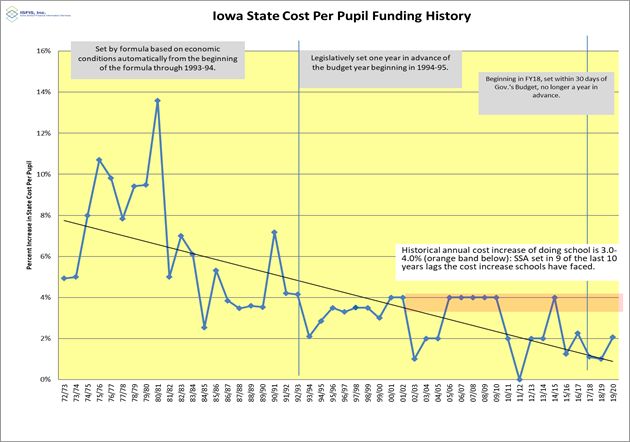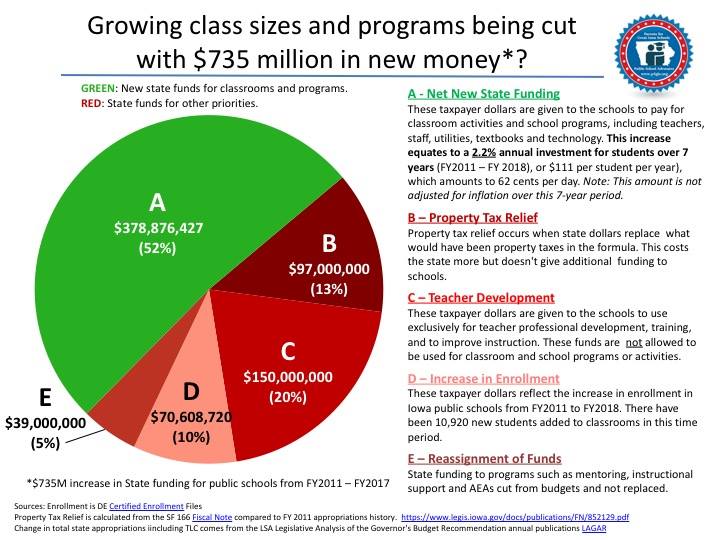UPDATE: Weeks after state law required the legislature to set school funding levels, House and Senate Republicans agreed in early March to a 2.3 percent increase in state funding for K-12 schools. That’s higher than past increases since Republicans gained full control of state government in 2017 but low by historical standards.
Many of Iowa’s public school districts will be forced to make cuts in the coming year, as state funding for K-12 education continues to lag behind rising costs.
Governor Kim Reynolds proposed spending about $95 million more on K-12 schools, which amounts to a 2.5 percent increase compared to the current fiscal year. But Republicans in control of the Iowa Senate favor a 2.1 percent increase in what is commonly known as supplemental state aid, which would give school districts about $76 million more to spend. They put the lower number into Senate File 2142, the education funding bill the chamber approved along party lines on February 10.
When the House took up the bill on February 11, Republicans approved an amendment consistent with the governor’s plan to increase state aid by 2.5 percent. Democrats in both chambers offered amendments to increase state funding for public schools by 3 percent (about $120 million), but House and Senate members rejected those proposals along party lines. The vote on final passage in the House was 52-48, as Republican Jeff Shipley joined all 47 Democrats to oppose the bill. (His reasons may differ from the Democrats’; Shipley didn’t support the amendment raising state aid by 3 percent.) UPDATE: Shipley told Bleeding Heartland, “If we had a serious discussion on any of the problems affecting schools, I would vote yes. If we addressed nutrition in a satisfactory way I would support 8%” school supplemental aid.
If Senate Republicans refuse to concur with the House version of the bill, a conference committee will settle the matter. Either way, 2.5 percent is the most state funding could increase in the coming year.
Many advocates for public education have argued funding needs to grow by at least 4 percent to offset rising costs, such as insurance premiums or salary increases (in many cases mandated by contracts). The School Administrators of Iowa requested a 3.75 percent increase for the coming year.
This chart, prepared by Iowa School Finance Information Services, shows that for decades since Iowa adopted the current school funding system in the early 1970s, state aid rarely grew by less than 3 percent per year. In contrast, state funding for K-12 schools has grown by 2 percent or less most years during the past decade. The increase hit the 4 percent mark only once since 2010.
A budget increase that fails to keep pace with costs is a cut in real terms. Many school districts have dealt with the constraints by cutting staff or programming. Linh Ta reported for Iowa Capital Dispatch that the state’s largest school district, Des Moines Public Schools, had to cut $24 million from its budget last year and will cut another $20 million in the coming year if the legislature approves the 2.5 percent increase. Reducing health benefits for employees was a major part of the cost cutting. In addition, class sizes in Des Moines high schools are up this year, and some buildings have fewer teachers or support staff.
Investing in public education is a key issue for many Democrats running for Republican-held Iowa House and Senate seats in 2020. Reynolds and GOP lawmakers often tout the hundreds of millions of dollars in “new money” the legislature has approved for school districts. However, only about half of that funding has gone toward classroom expenses, school programs, or teacher salaries. Parents for Great Iowa Schools created this chart in 2018 to illustrate the problem.
UPDATE: Here’s one small example of how budget cuts will affect students and teachers. Roosevelt High School in Des Moines cut its highly-regarded drama program to one half-time position. A teacher is losing his job, and teenagers who love theater productions will suffer the consequences in the coming years. LATER UPDATE: The Des Moines Public Schools restored that position at Roosevelt.




No Comments